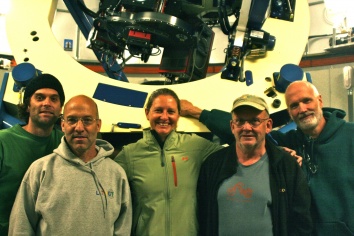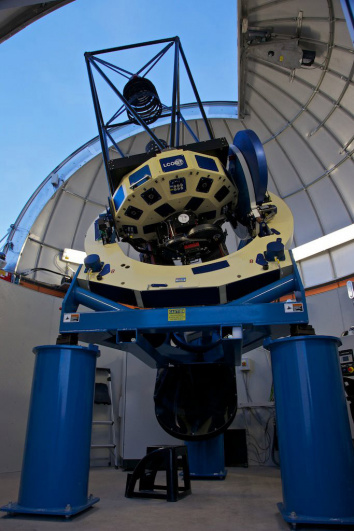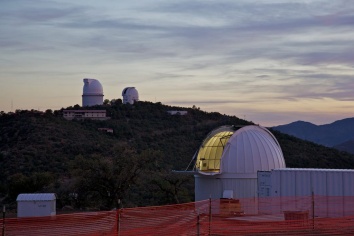Las Cumbres Telescope Sees First Light at McDonald Observatory
9 April 2012
FORT DAVIS, Texas — The first of a planned suite of telescopes of the Las Cumbres Observatory Global Telescope (LCOGT) Network achieved first light recently at The University of Texas at Austin's McDonald Observatory.
“We're thrilled,” said LCOGT Scientific Director Tim Brown, “to have our first telescope in such a well-supported site, with superbly dark skies.”
The 1-meter (40-inch) telescope will be used for both research and outreach to K-12 schools. It is part of a large planned network of LCOGT telescopes to be installed around the world, and the first of five (two 1-meter and three 0.4-meter) and possibly more LCOGT telescopes to be installed at McDonald Observatory over the next few years.
"This is the first telescope to be installed in a ring of facilities around the Earth that will give researchers and educators 24/7 access to astronomical objects," said McDonald Superintendent Tom Barnes. "As the Earth turns and daylight arrives at one facility, telescopes farther to the west will continue to monitor the research target.
"Researchers at McDonald Observatory will have share in access to all the world-wide telescopes in exchange for hosting one of the facilities," Barnes said.
The LCOGT network of telescopes will be fully operated and scheduled remotely and robotically. They will be used to search for extrasolar planets, track the exploding stars known as "supernovae," and observe near-Earth objects.
“Network users will concentrate on objects that change quickly,” Brown said. “If they orbit, or pulsate, or blow up, they're our stuff.”
Working together, McDonald staff and the team from LCOGT headed by manager Annie Hjelstrom went from an initial agreement to site the telescope at McDonald in February 2011 all the way to installation and first light in just over one year.
"That must be some kind of record," Barnes said.
The telescope will be tested and calibrated on-site over the next few days, then the LCOGT team will return to Goleta, California. They will continue to exercise and test the telescope remotely, and expect it to be available for scientific use later this spring.
LCOGT plans to complete the southern ring of 1-meter telescopes in the next year. Three telescopes are in final assembly in California now and will ship to Cerro Tololo Inter-American Observatory in Chile in approximately two months. Three more will ship to South Africa two months later, and two will go to Siding Spring, Australia.
In the Northern Hemisphere, two more 1-meter LCOGT telescopes will ship to McDonald Observatory in 2013. A site in Tenerife in the Canary Islands will receive three telescopes, and a site yet to be finalized in the Asia-Pacific region will also receive two or more telescopes.
Established in 1932, The University of Texas at Austin McDonald Observatory near Fort Davis, Texas, hosts multiple telescopes undertaking a wide range of astronomical research under the darkest night skies of any professional observatory in the continental United States. McDonald is home to the consortium-run Hobby- Eberly Telescope, one of the world's largest, which will soon be upgraded to begin the HET Dark Energy Experiment. An internationally known leader in astronomy education and outreach, McDonald Observatory is also pioneering the next generation of astronomical research as a founding partner of the Giant Magellan Telescope.
— END —
Note: For more information about Las Cumbres Observatory Global Telescope Network, see: http://lcogt.net
Media Contacts:
Rebecca Johnson, McDonald Observatory
David Petry, Las Cumbres Observatory Global Telescope Network








